Caryn

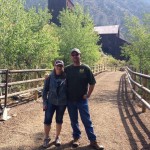 Some birthdays come and go without a lot of fanfare, but others come with a reminder of the blessings we have, and the things we could have lost. This year, for my niece, Kelli Schulenberg, hers is a birthday filled with reasons to be thankful. The recent fire that could have destroyed her home, also could have taken the life of her beloved dog, Dakota. While she was waiting to hear of the fate of her house, and the wellbeing of her dog, I had a chance to talk with, encourage, and pray with Kelli about the whole situation. Of course, her mind was filled with worry, but she showed a strength that told me that no matter what the outcome, she and my nephew Barry would pull through.
Some birthdays come and go without a lot of fanfare, but others come with a reminder of the blessings we have, and the things we could have lost. This year, for my niece, Kelli Schulenberg, hers is a birthday filled with reasons to be thankful. The recent fire that could have destroyed her home, also could have taken the life of her beloved dog, Dakota. While she was waiting to hear of the fate of her house, and the wellbeing of her dog, I had a chance to talk with, encourage, and pray with Kelli about the whole situation. Of course, her mind was filled with worry, but she showed a strength that told me that no matter what the outcome, she and my nephew Barry would pull through.
With Kelli’s birthday coming so close to Thanksgiving, I’m sure that there have been a number of years where her reasons for being thankful have mingled with her birthday wishes, but I doubt if any other year has brought that more into perspective than this year. When you come close to losing your home, your pet, and all of your cherished memories, it really serves as a reminder to be thankful for all God has given you, and all that He protected for you. Kelli and Barry’s home and their dog were spared, and they both know the feeling of thankfulness for that precious gift. The did lose some wood and trees, a trailer and a shed, but these were things that, while still a loss, can be replaced with much more ease than a home and less pain than a pet. Nevertheless, they were a loss.
But, as with most things we are thankful for, the best are the gifts given in our time of need. That certainly was the case for Kelli and Barry, when their family and friends came together to cut up more wood than they originally had. With the winter months set now with enough wood to keep their home warm and cozy, Kelli finds herself with yet another reason to be thankful the year, both on her birthday and Thanksgiving.
Some birthdays are a little bit sad, because we feel older now, or a loved one isn’t with us, but 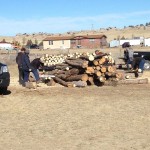
 I think that on this birthday, Kelli will not be thinking about the passing years, but rather about the blessings she has been given, especially in this past year. So much of her life could have been very different, had it not been for the prayers of friends and family, the hard work she and Barry had done to make sure their home had a good fire break around it, and the help of family and friends to give back the things lost. And of course, she is thankful to still have her dog, Dakota, thanks to the kindness of friends who made sure he was ok. Today is Kelli’s birthday. Happy birthday Kelli!! Have a great day!! We love you!!
I think that on this birthday, Kelli will not be thinking about the passing years, but rather about the blessings she has been given, especially in this past year. So much of her life could have been very different, had it not been for the prayers of friends and family, the hard work she and Barry had done to make sure their home had a good fire break around it, and the help of family and friends to give back the things lost. And of course, she is thankful to still have her dog, Dakota, thanks to the kindness of friends who made sure he was ok. Today is Kelli’s birthday. Happy birthday Kelli!! Have a great day!! We love you!!
 For some reason, time seems to fly by much faster as we get older than it did when we were young. Maybe it is because as kids, we could only think of being grown up. In reality, it’s too bad that we didn’t know that with growing up would come many other things that are not so pleasant as simply getting to be an adult. Responsibility is probably the first thing you suddenly notice, but it will not be the worst thing you will ever face. No, the worst thing is definitely loss, and it seems like the older we get, the more people we know who have passed away. It’s not just family, of course, but friends, parents and siblings of friends, and the worst…children.
For some reason, time seems to fly by much faster as we get older than it did when we were young. Maybe it is because as kids, we could only think of being grown up. In reality, it’s too bad that we didn’t know that with growing up would come many other things that are not so pleasant as simply getting to be an adult. Responsibility is probably the first thing you suddenly notice, but it will not be the worst thing you will ever face. No, the worst thing is definitely loss, and it seems like the older we get, the more people we know who have passed away. It’s not just family, of course, but friends, parents and siblings of friends, and the worst…children.
While the loss of our loved one is something that we deal with every day, there are days that are definitely worse. The anniversary of the day they passed, and in that first year, the day of the month that they passed. Today marks the 9 month anniversary of my mom’s passing, as well as the 5th anniversary of the passing of her little great granddaughter…Laila Spethman. While there is little comfort for those of us left behind, there is a degree of comfort in knowing that my parents are getting to know their two little granddaughters who left us too soon, Alyssa Harman and Laila Spethman. I know they are having such a great time, because for both Mom and Dad, there was nothing more important than family, and every little grandchild was very special. I know that the loss of two young great granddaughters was very hard on them, and I know that they are having a great time getting to know those girls.
The days that mark the loss of a loved one are always hard, and while we wish we didn’t have to face them, they are also days to remember. Our minds drift back to happy days, during their lives. We think about the sweet little memories, such as the one my sister Caryl Reed had yesterday. When she was giving a bed that  her husband Mike had made for our mom to use when she visited, to their grandson, Topher Spicer. As they were moving the bed, one of Mom’s curlers and a bobby pin were under the bed. They had fallen out the one time she got to sleep there. Caryl said it was like a little hug from Mom. As this nine month anniversary of her passing arrives, it’s like Mom is sending her love and telling us that she is having a wonderful time in Heaven with Dad, Alyssa, Laila, and the rest of the family who were there to greet her. While this day brings a dual sadness to our hearts, because we miss Mom and Laila, it also reminds us how happy they are, celebrating in Heaven, because there is no sadness or tears there. We love and miss you Mom and Laila, as well as Dad, Alyssa and all our other loved ones in Heaven. Someday soon we will see you again.
her husband Mike had made for our mom to use when she visited, to their grandson, Topher Spicer. As they were moving the bed, one of Mom’s curlers and a bobby pin were under the bed. They had fallen out the one time she got to sleep there. Caryl said it was like a little hug from Mom. As this nine month anniversary of her passing arrives, it’s like Mom is sending her love and telling us that she is having a wonderful time in Heaven with Dad, Alyssa, Laila, and the rest of the family who were there to greet her. While this day brings a dual sadness to our hearts, because we miss Mom and Laila, it also reminds us how happy they are, celebrating in Heaven, because there is no sadness or tears there. We love and miss you Mom and Laila, as well as Dad, Alyssa and all our other loved ones in Heaven. Someday soon we will see you again.
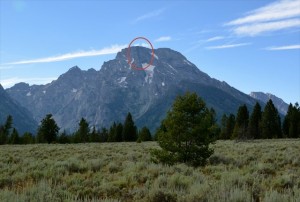 When I was about 10 years old or so, my family and my Uncle Bill’s family went to the Jackson, Wyoming area. While we were stopped at a lookout point for the Teton Mountains, my dad told a story, or maybe read the story about a plane that had crashed on Mount Moran on November 21, 1950. He told us that because of the difficulty in reaching the site, the plane and the remains of the 21 people lost in the crash were never removed from the site. My young mind could not seem to get past the fact that those bodies were still on that mountain top. I had a terrible time sleeping. I don’t know if I felt like we were somehow camping someplace we shouldn’t be, which was silly, because that site was miles from where we were camped. Nevertheless, it bothered me very much at that time. Now, many years later, I would know that the mountain was simply a burial place for the victims of a tragic crash.
When I was about 10 years old or so, my family and my Uncle Bill’s family went to the Jackson, Wyoming area. While we were stopped at a lookout point for the Teton Mountains, my dad told a story, or maybe read the story about a plane that had crashed on Mount Moran on November 21, 1950. He told us that because of the difficulty in reaching the site, the plane and the remains of the 21 people lost in the crash were never removed from the site. My young mind could not seem to get past the fact that those bodies were still on that mountain top. I had a terrible time sleeping. I don’t know if I felt like we were somehow camping someplace we shouldn’t be, which was silly, because that site was miles from where we were camped. Nevertheless, it bothered me very much at that time. Now, many years later, I would know that the mountain was simply a burial place for the victims of a tragic crash.
While I am no longer haunted by the thought of those lost ones buried in the ice at the top of the mountain, I really never lost my curiosity about the crash and just who those people were. Then, a few weeks ago, I found that today would be the 65th anniversary of that crash. It seemed like it was time to find out more about it. The plane, a new Douglas DC-3, was owned by New Tribes Mission. It was on the first leg of a trip to South America. It left Chico, California and was bound for Billings, Montana. The last radio report in was over Idaho Falls, Idaho at 3:48pm. Then it was reported overdue at Billings, leaving the sinking feeling that something tragic had happened. A resort owner said he saw a burning fuselage in the flames far above timberline on the east face of Mount Moran. When the fire subsided, he could see nothing resembling a campfire, which might have indicated survivors. Gaining access to the site was going to prove extremely difficult, and with temperatures seriously low, the chance of anyone making it through that first night were next to none. Of course, you can guess the outcome of the crash. All those on board were lost.
Removing the wreckage and the bodies of the victims proved to be a very difficult, if not impossible task, and in the end, it was decided that the wreckage and the remains would be left on the mountain. The crash site is just north of the top of the handle of Skillet Glacier. Sometimes a glint of the wreckage can be seen to this day on a sunny summer afternoon when the light is just right. The crash site remains a resting place for those lost souls, and hikers who pass the site are expected to show their respect by leaving this mountain gravesite undisturbed. The site is the burial ground for the ten men, four women, and seven children who’s remains are still entombed in the wreckage. I suppose that these days, while the plane might have been left on the mountain, the remains of the victims would have most certainly been removed allowing the families to give them a proper burial.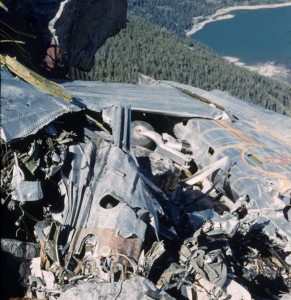
Hikers who have passed the wreckage have said that it has an eerie feeling. I’m sure it has to do with being so close to the remains of the victims of that horrible crash. I can totally relate to how they felt, because on that day, when we were camping just within sight of the mountain where the wreckage and the victims still remained, I could not sleep. I was not afraid of being haunted or anything silly like that, but rather I guess it felt like I was an intruder, much like the Native Americans felt when the White Man went through their burial grounds. It was just not the right place to be. I think I would feel even more like I was in the wrong place, if I ever hiked that mountain, and came upon that sight. I still have an eerie feeling about it to this day…or maybe it is just a sadness for those lost ones. I’m still not sure about that…to this day.

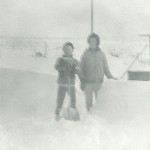 Every year, I dread the beginning of winter. It doesn’t matter how late it starts, I still wish it was over the minute it begins. I know that many people would say, why do you live where you do, and to that I say…it is where I have always lived…or at least since I was three years old. Before that, up until I was three years old, I lived in Superior, Wisconsin, and I must say that the weather there would have been worse than the winters here, so I have moved to a better place…sort of. Don’t get me wrong…I love Wyoming. It is my home, and in the fall, spring, and summer, I am perfectly happy here. I would just love to eliminate winter all together. I can’t say that I always felt that way about winter, because as a kid, I probably didn’t. I think our parents had no trouble getting my sisters and me to go outside and make snowmen, or snow angels, or build a fort and have a snowball fight. It’s what kids do. In reality it seems like winter bothers us more and more, the older we get. Even my sister, Cheryl Masterson, who loves winter, really has no true desire to be out in it. She likes the beauty of it and the coolness of the air, but shoveling snow or driving in snow…not so much.
Every year, I dread the beginning of winter. It doesn’t matter how late it starts, I still wish it was over the minute it begins. I know that many people would say, why do you live where you do, and to that I say…it is where I have always lived…or at least since I was three years old. Before that, up until I was three years old, I lived in Superior, Wisconsin, and I must say that the weather there would have been worse than the winters here, so I have moved to a better place…sort of. Don’t get me wrong…I love Wyoming. It is my home, and in the fall, spring, and summer, I am perfectly happy here. I would just love to eliminate winter all together. I can’t say that I always felt that way about winter, because as a kid, I probably didn’t. I think our parents had no trouble getting my sisters and me to go outside and make snowmen, or snow angels, or build a fort and have a snowball fight. It’s what kids do. In reality it seems like winter bothers us more and more, the older we get. Even my sister, Cheryl Masterson, who loves winter, really has no true desire to be out in it. She likes the beauty of it and the coolness of the air, but shoveling snow or driving in snow…not so much.
I guess it is a good thing that our lives have seasons too, because if they didn’t, I doubt if anyone would ever do those fun things that kids do in winter. If we all felt the way I do about winter right now, I suppose we would move to a different place every six months or so. That, of course is the snowbird stage of life, except that it would be something that happened much more often, and that is what I would be, were it not for my obligations here. For me, there is a love/hate relationship with the changing seasons. When spring rolls around, I will start to feel alive again, just like the flowers, trees, and birds. My heart sings as the warmer weather approaches, and I feel like hibernating during the colder months. The odd thing too, is that I love winter scenes…in pictures, but in reality, I have no desire to be there…just to look, and then to go out in the warm summer weather I truly love.
Perhaps I need to consider what the difference was when I was a child, and I really did like going out into the snowy weather. Was it that I didn’t mind the cold, or that I didn’t mind dressing for it? Is it that I have 
 forgotten how to play? Probably, that is it. In fact the last time I can say that I really played was when my grandchildren were little. I think it would be great if I could travel back in time those 15 or so years to when I would gladly have gone out in the snow with my grandchildren, because…well, I would do just about anything for them. I suppose that even then I can’t say I loved the cold, but I did have a great time playing with those grandchildren…even if it was cold. I can’t go back in time, so here I am at the beginning of another winter. The snow has arrived, the cold is here…and so it begins.
forgotten how to play? Probably, that is it. In fact the last time I can say that I really played was when my grandchildren were little. I think it would be great if I could travel back in time those 15 or so years to when I would gladly have gone out in the snow with my grandchildren, because…well, I would do just about anything for them. I suppose that even then I can’t say I loved the cold, but I did have a great time playing with those grandchildren…even if it was cold. I can’t go back in time, so here I am at the beginning of another winter. The snow has arrived, the cold is here…and so it begins.
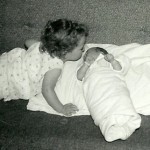
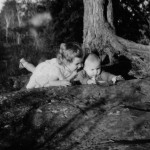 When I arrived…the second child in our family, I came home to not only my parents, but to my first friend…my sister, Cheryl Masterson. I don’t know what I would have done if she hadn’t been there. I know that sound silly, but when you are the younger sister, that older sister is pretty special. For a little kid, just starting out, it’s great to have an older sister and friend there to show you the ropes. She had hard job of navigating the rules of the household, and now she could tell me how things are supposed to go, and what you really don’t want to try, because it will get you in trouble. Of course, as a baby and even into my first year, I didn’t get into much trouble, but I’m pretty sure I made up for it later on.
When I arrived…the second child in our family, I came home to not only my parents, but to my first friend…my sister, Cheryl Masterson. I don’t know what I would have done if she hadn’t been there. I know that sound silly, but when you are the younger sister, that older sister is pretty special. For a little kid, just starting out, it’s great to have an older sister and friend there to show you the ropes. She had hard job of navigating the rules of the household, and now she could tell me how things are supposed to go, and what you really don’t want to try, because it will get you in trouble. Of course, as a baby and even into my first year, I didn’t get into much trouble, but I’m pretty sure I made up for it later on.
Of course, it wasn’t just having Cheryl show me how things were in our house that made that homecoming, and the subsequent years so special, but rather, the wonderful friendship we had as kids, and still have to this day. I know that my sister would give her right arm for me, because she is such a loving and giving person. I can always count on her to be there for me, and help me with anything she can, and I’m sure she knows that I feel the same way about her too. I have been blessed with four wonderful sisters, all of whom I love dearly, but Cheryl was the first one, and the leader of our little group of sisters. She as also the cool one, in my opinion. She always seemed to have it all together, and somehow I just didn’t. Maybe it was just the teenaged awkwardness, but my sister never seemed to go through it, so I looked up to her in her coolness.
I love that she and I shared those early childhood years. We were able to explore the wonder of the world around us together, and see all the sights our backyard had to offer. And then, because our parents liked to go sight seeing, we got to explore the sights of our home in Superior, Wisconsin. That was something our younger sisters never really got to do in the same way, because all were born and raised in Casper, Wyoming. Cheryl and I got to see a little bit of how our lives might have been different had we stayed in Wisconsin, when we visited our family there in August of 2014, and while our lives are here in Casper now, we both loved the area 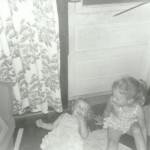
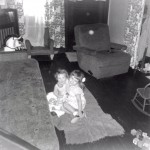 around Lake Superior. I guess it still felt like home to us, because it was where our roots are.
around Lake Superior. I guess it still felt like home to us, because it was where our roots are.
I think I am a very blessed sister to have the sisters I have, and that I was very blessed indeed, to have my sister Cheryl to come home to when I was born. You can’t pick your family…it’s true, but I know that if I could have, I wouldn’t have changed a single thing, because mine is the greatest family in the world. I know that may not be what other people think, but that’s my story, and I’m sticking to it.
 With Christmas fast approaching, I am reminded of the Christmas of 1984. With their cousin Jessica Hadlock Sawdon, arriving shortly before Christmas, my girls, Corrie Petersen and Amy Royce wanted to do something special for her…even though they didn’t know then if the baby was a boy or a girl. We could have gone and purchased a blanket, an outfit, or a toy, but so could anyone else. The girls wanted their gift to be different from what everyone else was going to give. They were learning to crochet, and so it was decided that Corrie would make a blanket and Amy would make a bonnet. They worked very hard on their gifts, and on Christmas morning, they proved to be a stunning success. My girls beamed with pride at how their gifts were received.
With Christmas fast approaching, I am reminded of the Christmas of 1984. With their cousin Jessica Hadlock Sawdon, arriving shortly before Christmas, my girls, Corrie Petersen and Amy Royce wanted to do something special for her…even though they didn’t know then if the baby was a boy or a girl. We could have gone and purchased a blanket, an outfit, or a toy, but so could anyone else. The girls wanted their gift to be different from what everyone else was going to give. They were learning to crochet, and so it was decided that Corrie would make a blanket and Amy would make a bonnet. They worked very hard on their gifts, and on Christmas morning, they proved to be a stunning success. My girls beamed with pride at how their gifts were received.
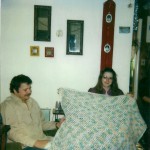 So often, these days, Christmas has become so commercialized that it often isn’t about the gift given, but rather about just how much was spent on it, that seems to matter. But, on that Christmas, for my girls, it was about their gift being made with love. Every stitch they put in the blanket and bonnet was a learning experience for them, and they couldn’t wait to see what their Aunt Allyn and Uncle Chris Hadlock thought of the gifts they had worked so hard on. Needless to say, the blanket and bonnet were very happily received. Their gift was a huge success, and no one gave a thought to how much money was or was not spent on it.
So often, these days, Christmas has become so commercialized that it often isn’t about the gift given, but rather about just how much was spent on it, that seems to matter. But, on that Christmas, for my girls, it was about their gift being made with love. Every stitch they put in the blanket and bonnet was a learning experience for them, and they couldn’t wait to see what their Aunt Allyn and Uncle Chris Hadlock thought of the gifts they had worked so hard on. Needless to say, the blanket and bonnet were very happily received. Their gift was a huge success, and no one gave a thought to how much money was or was not spent on it.
There were a lot of gifst given that day, and I’m sure that many were wonderful, and very much appreciated, but I also know that my sister, her husband, and now Jessi all remember the gifts that were made and given with love by two little girls who loved their new cousin very  much, even though they did not know her yet and in fact, didn’t know if she was a boy or a girl. The things we do for people out of love, while not necessarily expensive, are often the most treasured of the many things we receive over the years. They can’t be measured in a monitary way, because they are indeed priceless.
much, even though they did not know her yet and in fact, didn’t know if she was a boy or a girl. The things we do for people out of love, while not necessarily expensive, are often the most treasured of the many things we receive over the years. They can’t be measured in a monitary way, because they are indeed priceless.
As Christmas approaches, of course, the most important thing to remember is the reason for the season…Jesus…the Saviour of the world. Jesus was the greatest gift, but in today’s world, I think it is always a good idea to remember more than just the gifts we received, but rather the spirit in which they were given. Whenever we act in love, we give the greatest gift we could have given…ourselves. And that is priceless for sure.
 I don’t know about your family, but in my family, there are a number of “die hard” football fans. Basically the situation is this. If their team is playing, don’t walk in front of the television, unless it is a commercial. Now my husband, Bob Schulenberg and I are definitely “die hard” Broncos fans, but we don’t always watch the game. I suppose lots of people would say that if we don’t watch the games, we aren’t “die hard” fans, but I say we are. You will never see me going for another team if they are playing my Broncos. I will root for my kids teams, as long as they are not playing the Broncos. That’s just the way it is. Now, in our house, there is no big football fight, because both Bob and I agree that the Broncos are our team, but our kids have homes that are in football division, making game day a little more heated. Nevertheless, I doubt if game day was ever quite as heated in my kids houses as it was with the Heidi Bowl. For many of you, I’m sure that a question has now arisen…namely, “What is the Heidi Bowl?” In fact, I’m sure that many of you are wondering if I know anything about football at all. True enough, there are a number of Bowl games played, with the ultimate one being the Super Bowl, and yes, I do know about football, and I assure you that the Heidi Bowl did exist.
I don’t know about your family, but in my family, there are a number of “die hard” football fans. Basically the situation is this. If their team is playing, don’t walk in front of the television, unless it is a commercial. Now my husband, Bob Schulenberg and I are definitely “die hard” Broncos fans, but we don’t always watch the game. I suppose lots of people would say that if we don’t watch the games, we aren’t “die hard” fans, but I say we are. You will never see me going for another team if they are playing my Broncos. I will root for my kids teams, as long as they are not playing the Broncos. That’s just the way it is. Now, in our house, there is no big football fight, because both Bob and I agree that the Broncos are our team, but our kids have homes that are in football division, making game day a little more heated. Nevertheless, I doubt if game day was ever quite as heated in my kids houses as it was with the Heidi Bowl. For many of you, I’m sure that a question has now arisen…namely, “What is the Heidi Bowl?” In fact, I’m sure that many of you are wondering if I know anything about football at all. True enough, there are a number of Bowl games played, with the ultimate one being the Super Bowl, and yes, I do know about football, and I assure you that the Heidi Bowl did exist.
The Heidi Bowl was played on November 17, 1968. The two teams were the Oakland Raiders and the New York Jets. The game between the Jets and the Raiders was a classic nail biter. It featured two of the league’s best teams and 10 future Hall of Fame players. With a little more than a minute left to play, the Jets kicked a 26-yard field goal that gave them a 32-29 lead. After the New York kickoff, the Raiders returned the ball to their own 23-yard line. What happened after that will go down in football history. The Raiders quarterback Daryle Lamonica threw a 20 yard pass to halfback Charlie Smith. A facemask penalty moved the ball to the Jets’ 43 yard line, and on the next play, Lamonica passed again to Smith, who ran it all the way for a touchdown. The Raiders took the lead…32-36. Then the Jets fumbled the kickoff. Oakland’s Preston Ridlehuber managed to grab the ball and run it two yards for another touchdown. Oakland had scored twice in nine seconds, and the game was over. Oakland won…43-32.
I’m sure you are still wondering how this was called the Heidi Bowl. Well, I’ll tell you. At the point where the game had just 65 seconds left, NBC switched off the game and put on the movie, Heidi, which had been scheduled to start at that point. The Oakland Raiders came from behind to score two touchdowns in nine seconds. They beat the New York Jets…and no one saw it, because they’re watching the movie Heidi instead. So the only people who got to see the end of that intense game were the people in the stands. Viewers were outraged, and they complained so vehemently that network executives learned a lesson they’ll never forget. “Whatever you do,” one said, “you better not leave an NFL football game.” It didn’t matter what was scheduled…the game is played out. 
The Heidi Bowl was not a Bowl game that anyone, who loves football, ever wanted to watch, but it was one that was played, nevertheless. For anyone who doesn’t care about football, I’m sure that the thought was, “Oh for Pete’s sake, what is the problem?” Well, that was not the question for the NBC executives ever again. The problem is a huge one. Ratings!! If you want the ratings, don’t make such a big mistake as to jump out of a game 65 seconds before it’s over. Sure, most of the time there wouldn’t be much change, but you just never know…and if it does, you don’t want to deal with the aftermath.
 A while back, I wrote a funny little story about my oldest daughter, Corrie Petersen’s early attempts at wearing makeup. Since she was about three at the time, I can imagine you already know just how skillfully her makeup was applied that day. Most little girls are that way though. Their first makeup attempts usually come from sneaking into mommy’s makeup and usually, making a real mess of it, and of their face. Mascara is one of the worst…or at least the funniest things that girls apply, because it is usually black, and they have no idea how to put it on their eyelashes, but they know that is where it goes. Needless to say, it ends up being all over their eyes and their face, but they think it looks great, because their mommy does it, so it is just what everyone should be doing. Anyone who understands human nature, knows that imitation is the most sincere form of flattery, and every little girl wants to be just like her mommy.
A while back, I wrote a funny little story about my oldest daughter, Corrie Petersen’s early attempts at wearing makeup. Since she was about three at the time, I can imagine you already know just how skillfully her makeup was applied that day. Most little girls are that way though. Their first makeup attempts usually come from sneaking into mommy’s makeup and usually, making a real mess of it, and of their face. Mascara is one of the worst…or at least the funniest things that girls apply, because it is usually black, and they have no idea how to put it on their eyelashes, but they know that is where it goes. Needless to say, it ends up being all over their eyes and their face, but they think it looks great, because their mommy does it, so it is just what everyone should be doing. Anyone who understands human nature, knows that imitation is the most sincere form of flattery, and every little girl wants to be just like her mommy.
When I posted the story about Corrie getting into my makeup, I thought is was pretty funny, but now I see, that like Corrie’s sister, Amy, who was so much like me in that she held the kitties by the neck, the apple didn’t fall too far from the tree with my daughter Corrie either. Apparently, Corrie’s mom…i.e. me, was one of those little girls who wanted to flatter my mom by immitating her too. Mom caught me in a picture getting into her purse, and putting on her makeup. Of course, I don’t know what the aftermath was of that particular event, but I think that like most moms, my mom thought it was too cute to be mad about. And after all, if you don’t want your kids getting into your makeup, don’t leave your purse where your little one can get too it…right? Still, I don’t know of one mom who hasn’t had her child get into her purse once or twice.
That purse is another thing that little girls just love to play with. They know that the things in that purse are 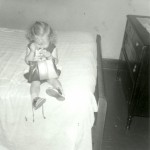 very important, or their mommy wouldn’t have one…right. It is simply a girly girl thing, and would we really have it any other way. Of course not. There is really nothing better that having our little daughter be our mini-me…whether that means clothes, purses, or as in the case of my mom, my daughter, and me, makeup. It’s funny that years later, when I was suddenly old enough to be allowed to wear makeup, I wasn’t as interested as my mother would have hoped…at least as far as lipstick was concerned. I wore mascara, but the rest of it…no, not for years anyway. We all grow up and realize…finally, what things look good and what things don’t. In my case, while our color preferences are different, my mom and I both wore pretty much the same types of makeup…including lipstick. I guess my mom knew what was pretty after all. Go figure.
very important, or their mommy wouldn’t have one…right. It is simply a girly girl thing, and would we really have it any other way. Of course not. There is really nothing better that having our little daughter be our mini-me…whether that means clothes, purses, or as in the case of my mom, my daughter, and me, makeup. It’s funny that years later, when I was suddenly old enough to be allowed to wear makeup, I wasn’t as interested as my mother would have hoped…at least as far as lipstick was concerned. I wore mascara, but the rest of it…no, not for years anyway. We all grow up and realize…finally, what things look good and what things don’t. In my case, while our color preferences are different, my mom and I both wore pretty much the same types of makeup…including lipstick. I guess my mom knew what was pretty after all. Go figure.
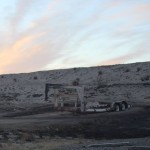
 On October 11, 2015, a wildfire devastated a large area north of Casper, including the area where my nephew, Barry Schulenberg and his wife, Kelli live. While their house was not one that was damaged, they did not escape unscathed. They lost a shed with some lawn equipment in it, fifteen or more trees, a flatbed trailer, and about eight cords of wood, which was enough to heat their home for the coming winter, just to name a few of the things. While insurance will reimburse them for some of the loss, it will not cover all of it, nor will it even begin to reimburse them for the many hours spent cutting all that wood the first time. And the hardest thing to get back…peace of mind.
On October 11, 2015, a wildfire devastated a large area north of Casper, including the area where my nephew, Barry Schulenberg and his wife, Kelli live. While their house was not one that was damaged, they did not escape unscathed. They lost a shed with some lawn equipment in it, fifteen or more trees, a flatbed trailer, and about eight cords of wood, which was enough to heat their home for the coming winter, just to name a few of the things. While insurance will reimburse them for some of the loss, it will not cover all of it, nor will it even begin to reimburse them for the many hours spent cutting all that wood the first time. And the hardest thing to get back…peace of mind.
People would call them lucky, that so much of their property was spared, but I don’t really think anyone who lost anything in that fire, that took 10,000 acres, 12 homes, a number of animals, and several other structures, considers themselves lucky…except that they made it out alive. I still don’t consider that luck. I believe it was the prayers of the people of Casper and others around the nation that kept the loss to the relative minimum that it ended up being, compared to other large fires.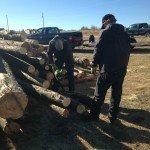

In the aftermath, many people have donated money and other needed items to those who suffered loss that dreadful day, and many will continue to do so. There is no way for me to talk about them all, but they know how much the people who they have helped appreciated it. Help after a loss never goes unnoticed. It is a show of love, kindness, and compassion that can never be repaid. People helping people…the giving spirit. It is what people do for those in need.
As for Barry and Kelli Schulenberg, a special family and friends benefit took place yesterday, when a dozen people converged on my brother-in-law and sister-in-law, Ron and Rachel Schulenberg’s place, where thankfully, Barry and Kelli still had some wood, waiting to be cut. Those dozen people spent most of the day cutting, loading, and unloading the ten cords of wood, that now sits where the first eight cords had been at Barry and Kelli’s place. I know that they already feel much better about the coming winter, because without all that wood, it would have been a much more expensive winter in the heating department.
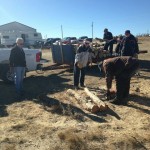
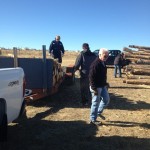 The things that Barry, Kelli, and the other fire victims lost in the fire will at least partially be replaced, but the thing you can’t put a value on is the helping hands of the people who stepped up to help you rebuild your life. The fire victims lost a lot of things, but things can be replaced. Nevertheless, cleanup, replanting, re-cutting of wood, and so many other things that had to be done after a fire, take time and effort. I have to give a lot of credit to anyone who helped to put the lives of the fire victims back together. The kindness of those helping hands was a blessing that will never be forgotten.
The things that Barry, Kelli, and the other fire victims lost in the fire will at least partially be replaced, but the thing you can’t put a value on is the helping hands of the people who stepped up to help you rebuild your life. The fire victims lost a lot of things, but things can be replaced. Nevertheless, cleanup, replanting, re-cutting of wood, and so many other things that had to be done after a fire, take time and effort. I have to give a lot of credit to anyone who helped to put the lives of the fire victims back together. The kindness of those helping hands was a blessing that will never be forgotten.
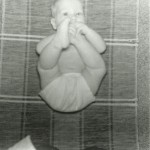
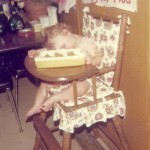 Babies are so cute. They do things that we as adults can’t do, not only because we would be looked upon as a little off in the head, but because, lets face it…we don’t bend like that anymore. Things like trying to suck on our toes, like my sister, Caryl Reed is doing here, would be looked upon as disgusting, if they were done by adults, and in all reality, most adults would be hard pressed to get their feet to their mouth, although, I’m sure there are those who can do it. If you are one of those, it is probably best to keep it to yourself, because, as I said, people will think you are a little off in the head if you were to do that in public. And yet, we all find the pictures of babies sucking on their toes, to be so cute, that they are definitely Facebook worthy which is one of the highest compliments a picture can get these days. Of course, your baby isn’t really sucking on their toes because they taste good, but rather because they are curious about them, still we would look pretty ridiculous doing the same thing. Kids can get away with goofy stuff, but adults…not so much.
Babies are so cute. They do things that we as adults can’t do, not only because we would be looked upon as a little off in the head, but because, lets face it…we don’t bend like that anymore. Things like trying to suck on our toes, like my sister, Caryl Reed is doing here, would be looked upon as disgusting, if they were done by adults, and in all reality, most adults would be hard pressed to get their feet to their mouth, although, I’m sure there are those who can do it. If you are one of those, it is probably best to keep it to yourself, because, as I said, people will think you are a little off in the head if you were to do that in public. And yet, we all find the pictures of babies sucking on their toes, to be so cute, that they are definitely Facebook worthy which is one of the highest compliments a picture can get these days. Of course, your baby isn’t really sucking on their toes because they taste good, but rather because they are curious about them, still we would look pretty ridiculous doing the same thing. Kids can get away with goofy stuff, but adults…not so much.
Another way that kids have all the freedom over adults is the area of eating and table manners. No one gives a second thought to the mess kids make at the dinner table…until it comes time to clean it up, anyway. When a baby puts a whole bowl of spaghetti on their head, it’s funny. When they like their food so much that they use their hands and shovel it in to the point of wearing almost as much of it on their face as they put in their tummy, it’s funny. When they fall asleep in their food, because lets face it, eating is hard work…it’s funny, and you still have to wonder how they can bend like that. Most adults would have to be drunk to fall asleep comfortably in their plate of food, but kids often do it without a bit of trouble.
And, of course, there are the non-food things that kids do that we as adults probably had better not do. My niece Aleesia Spethman walks in the door of her grandma, my sister, Cheryl Masterson’s house, and before very long, off come most of the clothes. And if there are any pretty shoes around, she is clomping around in those far too big for her shoes, looking like a princess, even thought all she has on is a diaper…or these days, underwear. Of course, Aleesia comes from a family, her 
 grandmother and Aunt Chantel Balcerzak for sure, who are very warm blood people. The removal of the clothes can be a matter of being too hot. Nevertheless, her grandma and her aunt, certainly do not have the luxury of being able to run around in just a diaper, because as with so many other things kids do, that would be ridiculous. Childhood is a special time when these goofy, messy, and absolutely kid things can be done, and no one thinks it odd. It’s a time to find out about all the yummy things life has to offer, and a time to live free of embarrassment, restrictions, limits, and inhibitions.
grandmother and Aunt Chantel Balcerzak for sure, who are very warm blood people. The removal of the clothes can be a matter of being too hot. Nevertheless, her grandma and her aunt, certainly do not have the luxury of being able to run around in just a diaper, because as with so many other things kids do, that would be ridiculous. Childhood is a special time when these goofy, messy, and absolutely kid things can be done, and no one thinks it odd. It’s a time to find out about all the yummy things life has to offer, and a time to live free of embarrassment, restrictions, limits, and inhibitions.

